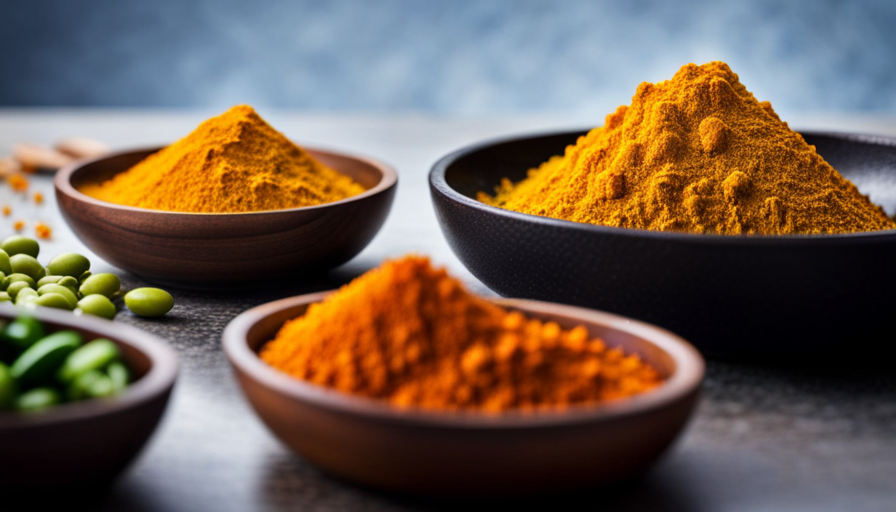The popular saying goes, “an apple a day keeps the doctor away.”
But what if I told you that there’s another way to keep inflammation at bay? Enter turmeric tea. This warm and soothing beverage has been a staple in traditional medicine for centuries, and for good reason. Turmeric, the star ingredient in this tea, is packed with anti-inflammatory properties that can help reduce swelling and pain in the body.
If you’re someone who suffers from chronic inflammation, turmeric tea might just be the natural remedy you’ve been looking for. Not only is it easy to make, but it’s also a delicious way to incorporate more health benefits into your daily routine.
In this article, I’ll be sharing with you everything you need to know about making turmeric tea for inflammation, from gathering your ingredients to customizing your tea to your liking. So sit back, relax, and let’s get brewing!
Key Takeaways
- Turmeric tea is a natural remedy for chronic inflammation due to the presence of curcumin.
- Fresh turmeric root is preferred for maximum anti-inflammatory properties and ginger and black pepper can enhance its absorption and flavor.
- Customizing turmeric tea with honey, lemon, or alternative sweeteners can offer additional health benefits.
- Drinking turmeric tea in the morning and pairing it with meals can reduce inflammation and improve digestion.
Understanding the Benefits of Turmeric Tea
Let’s take a closer look at the awesome benefits of sipping on turmeric tea. The health benefits of turmeric have been widely documented by scientific research.
Turmeric contains a powerful anti-inflammatory compound called curcumin, which has been shown to reduce inflammation in the body and alleviate symptoms of conditions such as arthritis, heart disease, and even certain types of cancer.
Not only is turmeric anti-inflammatory, but it’s also a powerful antioxidant. Antioxidants are important for protecting our cells from damage caused by free radicals, which can lead to the development of chronic diseases. Regularly consuming turmeric tea can help boost your body’s antioxidant levels and protect against oxidative stress.
With all of these amazing benefits, it’s no wonder turmeric tea has become a popular choice for those looking to improve their overall health.
Now, let’s move on to gathering your ingredients.
Gathering Your Ingredients
First things first, you gotta grab all the ingredients you need for this golden elixir! Don’t forget to add some pizzazz to your shopping list with a little bit of ginger.
Here are the ingredients you’ll need to make a delicious cup of turmeric tea:
- Turmeric powder or fresh turmeric root
- Fresh ginger
- Black pepper
- Honey or lemon (optional)
Turmeric tea benefits are numerous, and it’s important to get the right ingredients to maximize its anti-inflammatory properties. Fresh turmeric root is preferred because it contains higher levels of curcumin, the active component that gives turmeric its anti-inflammatory properties.
Adding ginger to your tea not only enhances its flavor, but it also has its own anti-inflammatory benefits. Black pepper is also important to add because it increases the absorption of curcumin in turmeric.
Now that we have our ingredients, it’s time to move on to preparing your turmeric tea.
Preparing Your Turmeric Tea
To start brewing your golden elixir, begin by grating a small piece of fresh ginger and adding it to a pot of boiling water along with a pinch of black pepper.
After a few minutes, add in one teaspoon of turmeric powder or a small piece of fresh turmeric root. Let the mixture boil for about 10 minutes, stirring occasionally.
If you prefer a milder taste, you can also try the cold brew method. Simply mix one teaspoon of turmeric powder with a cup of cold water and stir well.
Let the mixture sit for a few hours, or even overnight, in the fridge. Strain the liquid before drinking and add honey or lemon to taste.
Now that you know how to prepare your turmeric tea using either the boiling or cold brew method, it’s time to customize it to your liking.
Customizing Your Turmeric Tea
Now that I know how to make turmeric tea for inflammation, I want to explore different ways to customize my drink.
One way to add some sweetness is by adding honey or lemon. However, if you’re looking for alternative sweeteners, there are many options available such as maple syrup or stevia.
Additionally, experimenting with different spices such as ginger or cinnamon can enhance the flavor and health benefits of your turmeric tea.
Adding Honey or Lemon
If you’re feeling adventurous, throw in a dollop of honey or a squeeze of lemon to give your turmeric tea a burst of flavor that will knock your socks off! Not only do honey and lemon add a delicious twist to your turmeric tea, but they also offer numerous health benefits that complement the anti-inflammatory properties of turmeric.
Benefits of honey and lemon in turmeric tea include their ability to boost the immune system, fight off infections, and aid in digestion. Honey is a natural sweetener that’s rich in antioxidants and has antibacterial properties. Similarly, lemon is packed with vitamin C and citric acid, which help to support the immune system and cleanse the body of toxins.
Adding these ingredients to your turmeric tea can enhance its anti-inflammatory effects and provide a host of other health benefits. So, go ahead and sweeten your turmeric tea with honey or lemon for a delicious and nutritious beverage!
In the next section, we’ll explore using alternative sweeteners to customize your turmeric tea even further.
Using Alternative Sweeteners
Switching up your sweetener options can add a whole new dimension to the flavor profile of your golden elixir. While honey and lemon are popular choices, there are other natural sweeteners that can provide unique flavors and added health benefits. Here are some alternative sweeteners to consider when making turmeric tea for inflammation:
| Sweetener | Flavor Profile | Health Benefits |
|---|---|---|
| Maple Syrup | Earthy, Sweet | High in Antioxidants, Anti-Inflammatory |
| Stevia | Sweet, Herbal | Lowers Blood Sugar, Zero Calories |
| Coconut Sugar | Caramel, Nutty | Low Glycemic Index, Rich in Vitamins |
| Molasses | Bold, Bitter-Sweet | High in Iron, Calcium, and Magnesium |
As you can see, each sweetener has its own unique flavor profile and health benefits. Experimenting with different natural sweeteners can not only add variety to your turmeric tea, but also provide additional nutrients and health benefits.
Now, let’s move on to the next section and explore how different spices can enhance the flavor and health benefits of your turmeric tea.
Experimenting with Different Spices
Get ready to spice up your golden elixir and take your taste buds on a flavorful journey that’ll leave you feeling satisfied and nourished. Turmeric tea doesn’t have to be boring, and experimenting with different spice combinations can add even more health benefits.
Adding black pepper to your turmeric tea can increase the bioavailability of curcumin, the active ingredient in turmeric, by up to 2000%. This means that your body can absorb more of the anti-inflammatory and antioxidant benefits that turmeric has to offer.
Cinnamon is another spice that pairs well with turmeric and can add a delicious sweetness to your tea. Cinnamon has its own unique health benefits, such as improving blood sugar control and reducing inflammation.
You can also try adding ginger or cardamom to your turmeric tea for an extra kick of flavor and added health benefits. Experiment with different spice combinations to find the perfect combination that suits your taste buds and health needs.
Incorporating turmeric tea into your daily routine is easy and can have numerous health benefits. Start your day off with a warm cup of turmeric tea to reduce inflammation, boost your immune system, and improve your overall health.
Incorporating Turmeric Tea into Your Daily Routine
When incorporating turmeric tea into my daily routine, I’ve found it helpful to consider the best time to drink it. I prefer enjoying a cup in the morning as a refreshing start to my day.
Additionally, I like to pair turmeric tea with meals for added flavor and health benefits.
Lastly, I make sure to store any leftover tea in the fridge to enjoy later or use as a base for a salad dressing or marinade. These simple tips have helped me make turmeric tea a regular part of my healthy lifestyle.
Finding the Right Time to Drink Turmeric Tea
First thing in the morning, you’ll feel the soothing effects of turmeric tea on your inflamed body. The best brewing methods for turmeric tea involve boiling water and adding turmeric powder or grated turmeric root.
Timing strategies for this subtopic include drinking turmeric tea before or after meals, or at any time of day when you feel inflammation or pain. Health benefits of timing turmeric tea include reducing inflammation, improving digestion, and boosting immunity.
Optimal turmeric tea drinking times may vary depending on your individual needs and preferences. Some people prefer to drink turmeric tea in the morning to start their day off on the right foot, while others prefer to drink it before bed to promote relaxation and restful sleep. Pairing turmeric tea with meals can also be a great way to enhance the flavor and health benefits of your food.
By incorporating turmeric tea into your daily routine, you can experience the many benefits of this powerful anti-inflammatory spice.
Pairing Turmeric Tea with Meals
Now that we know when the best time is to drink turmeric tea, let’s talk about how to pair it with meals. Turmeric tea is a popular beverage due to its numerous health benefits, such as reducing inflammation and improving digestion.
Pairing it with certain meals can enhance these benefits and make for a delicious and healthy meal. When it comes to meal pairing, turmeric tea goes well with dishes that have a strong flavor profile, such as spicy or savory dishes. It can also be paired with sweet dishes, such as fruit salads or oatmeal.
The anti-inflammatory properties of turmeric can help counteract the negative effects of certain foods, such as processed or fried foods. Additionally, drinking turmeric tea after a meal can help with digestion and reduce bloating.
Overall, pairing turmeric tea with meals is a simple and effective way to incorporate this powerful spice into your diet. Speaking of incorporating turmeric into your diet, what do you do with leftover turmeric tea? The next section will cover how to store it for later use.
Storing Leftover Turmeric Tea
To store leftover turmeric tea, simply transfer it to an airtight container and refrigerate it for up to 3 days. This will help preserve its flavor and ensure that it remains safe to consume.
When reheating the tea, avoid using the microwave as it can destroy some of the beneficial compounds in turmeric. Instead, gently heat the tea on the stove or in a kettle until it reaches your desired temperature.
Storing tips:
- Use an airtight container to prevent the tea from absorbing any odors or flavors from other foods in the fridge.
- Label the container with the date you made the tea to ensure that you don’t consume it past its expiration date.
- If you have leftover tea that you won’t be able to drink within 3 days, consider freezing it in ice cube trays to use in smoothies or other recipes later on.
Overall, storing leftover turmeric tea is simple and straightforward. By following these tips, you can ensure that you’re able to enjoy the benefits of turmeric for days to come.
Frequently Asked Questions
Can turmeric tea be made with fresh turmeric root instead of powder?
Yes, fresh turmeric root can be used to make turmeric tea. The benefits of using fresh turmeric root in tea include higher levels of the active ingredient curcumin, which has anti-inflammatory properties.
How long should the turmeric tea steep for optimal health benefits?
After researching, I found that steeping turmeric tea for 10-15 minutes is optimal for health benefits. Using fresh turmeric root is more potent than the powder. It can aid in weight loss and has anti-inflammatory properties.
Can honey be used as a sweetener in turmeric tea instead of sugar?
Honey is a great alternative to sugar in turmeric tea as it offers numerous health benefits. It contains antioxidants, antibacterial properties, and may help reduce inflammation. However, other natural sweeteners like maple syrup and stevia can also be used.
Are there any potential side effects of consuming turmeric tea regularly?
What are the potential side effects of consuming turmeric tea regularly? It’s important to note that high doses can cause gastrointestinal distress and interact with certain medications. Recommended dosage is 1-3 grams per day.
Can turmeric tea help with weight loss or is it primarily used for inflammation?
Turmeric tea can help with weight loss due to its anti-inflammatory properties. It may aid in reducing inflammation in fat cells, leading to weight loss benefits. However, it should not be relied upon solely for weight loss.
Conclusion
Overall, making turmeric tea is a simple and delicious way to reap the many benefits of this powerful anti-inflammatory spice. By incorporating turmeric tea into your daily routine, you can help reduce inflammation and improve overall health.
Plus, with the added benefits of ginger, honey, and lemon, your turmeric tea can be tailored to your personal tastes and preferences. Some may argue that they don’t have the time or resources to make turmeric tea at home. However, with just a few simple ingredients and a few minutes of prep time, turmeric tea can easily be made in the comfort of your own kitchen.
By making your own turmeric tea, you can ensure that you are getting the highest quality ingredients and avoiding any unnecessary additives or preservatives. Overall, the benefits of turmeric tea are clear, and with a little bit of effort, you can easily incorporate this powerful spice into your daily routine.
So why not give it a try? Your body will thank you for it!










